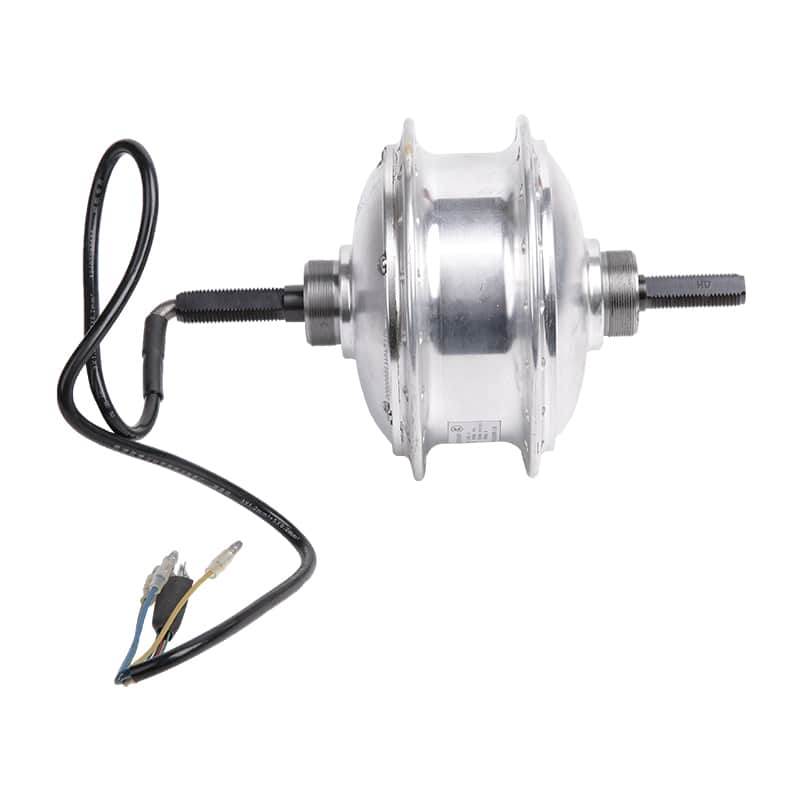

1. Introduction
The core of an electric bicycle isn't just the battery; the motor is also a key component that determines the riding experience. The motor's location and type directly impact handling, climbing ability, range, and overall balance.
E-bike motors on the market are primarily categorized into three types: front-wheel drive (FWD), rear-wheel drive (RWD), and mid-drive (MWD). Each type has its own advantages and limitations. Choosing the right motor for your needs depends on your riding scenario, load requirements, budget, and personal handling preferences.

2. Front-wheel Drive (FWD) Motor
Structural Features
FWD motors are mounted in the center of the front wheel hub, directly driving the front wheel. They are typically small, lightweight, and relatively simple in structure.
Advantages
Low Cost: Front-wheel drive motors are relatively inexpensive to manufacture and install, making them a common choice for entry-level E-bikes.
Easy Maintenance: Their simple structure allows for quick removal in the event of a malfunction.
Flexible Installation: They can be directly installed on standard bicycles, reducing modification costs. Lightweight Design: The front-wheel motor takes up little space and has a limited impact on the vehicle's weight.
Disadvantages: Limited grip: When going uphill or on slippery roads, the front wheel can easily slip, affecting power transfer.
Light handling: Front-wheel drive shifts the vehicle's center of gravity rearward, resulting in a slight float when turning.
Weak climbing ability: Power output is generally lower than that of rear-wheel drive and mid-mounted motors, limiting riding on steep slopes.
Suitable Scenarios: Urban commuting on flat roads; Lightweight leisure riding; Short-distance commuting with low power requirements.
Example: For example, a 250W front-wheel drive e-bike is suitable for urban riding, can maintain an average speed of 2025 km/h, and has a range of approximately 5070 km on a full charge.
3. Rear Hub Motor
Structural Features: The rear-wheel motor is mounted on the rear wheel hub and provides power by driving the rear wheel. It generally has higher power than a front-wheel drive motor and is suitable for carrying larger loads. Advantages
Strong Grip: The rear wheel carries the rider's weight, providing more stable traction and superior climbing performance compared to front-wheel drive.
Excellent Climbing Ability: High torque output makes it suitable for steeper slopes.
Suitable Loads: Rear-wheel drive motors are suitable for carrying people or heavy objects.
Disadvantages: Slightly Higher Cost: More expensive than front-wheel drive motors, and slightly more complicated to install and maintain.
Weight Impact: The added weight of the rear wheel makes transporting or tire replacement more difficult.
High Frame Requirements: Some frames do not support rear-wheel motor modifications.
Suitable Applications: Urban commuting with complex roads (including hills or slippery sections); Carrying heavy cargo or riding with two people; Light off-road or mixed-surface mountain biking.
Example: A 500W rear-wheel drive motor e-bike can maintain a speed of approximately 15-18 km/h on a 10% uphill slope, making it ideal for riding with a heavy load or long-distance travel.
4. Mid-Drive Motor
Structural Features
A mid-drive motor is mounted on the bicycle's center axle and drives the rear wheel via a chain. It's commonly found on high-performance, mountain biking, and long-distance e-bikes.
Advantages
Weight Balance: The motor is located in the center of the bike, resulting in a low center of gravity and excellent handling stability.
High Torque Output: Power is directly applied to the chain, making it easy to navigate steep slopes and difficult terrain.
High Efficiency: This allows the bike's transmission system to be fully utilized, resulting in increased riding efficiency.
Suitable for long-distance and mountain biking: It outperforms hub motors in complex conditions.
Disadvantages
High Price: The mid-drive motor and accompanying controller are relatively expensive, increasing the overall cost of the bike.
Complex Maintenance: Installation and maintenance are challenging and require specialized tools.
Fast Chain Wear: High torque accelerates chain and chainring wear, requiring regular maintenance. Suitable Scenarios
Mountain Biking and Off-Road
Long-Distance Tours and High-Load Rides
Cyclists with High Control and Performance Requirements
Example
A 750W mid-mounted motor mountain e-bike offers smooth riding on a 15% grade, while also offering high-speed flat road riding and long-range range. It's the top choice for high-performance riders.
5. How to Choose the Right Motor for You
Considering Road Conditions
Flat Roads → Front-Wheel Drive or Rear-Wheel Drive is sufficient
Uphill or Tall Roads → Mid-Wheel Drive or Rear-Wheel Drive is preferred
Considering Load
Lightweight Solo Ride → Front-Wheel Drive or a Low-Power Mid-Motor is sufficient
Heavy-Load or Two-Person Ride → Rear-Wheel Drive or a High-Power Mid-Motor is more suitable
Budget and Maintenance
Limited Budget → Front-Wheel Drive is the most economical
Performance → Mid-Motor Drive is the most reliable, but also has a higher cost
Control Preferences
Prefer Lightness and Simplicity → Front-Wheel Drive or Rear-Wheel Drive
Prefer Precise Control and Stability → Mid-Motor Drive